
The Evolution of the Google TV Standard Launcher: What Telcos Need to Know
Launchers as the Gateway to the TV Experience
In the dynamic OTT streaming landscape, the home screen is the primary gateway to content, engagement, and monetization. For operators building their offering on Android TV, the launcher plays a strategic role. It’s the first thing a user sees when they turn on the TV or set-top box, and it shapes how they discover and consume content.
The launcher defines not only the user experience but also how services are positioned, how content is surfaced, and how much control an operator can retain over branding and monetization. Understanding Google’s launcher strategy, particularly the transition from legacy options to the new standard, is essential for operators planning their next platform rollout or upgrade.
Understanding Launchers on Google TV
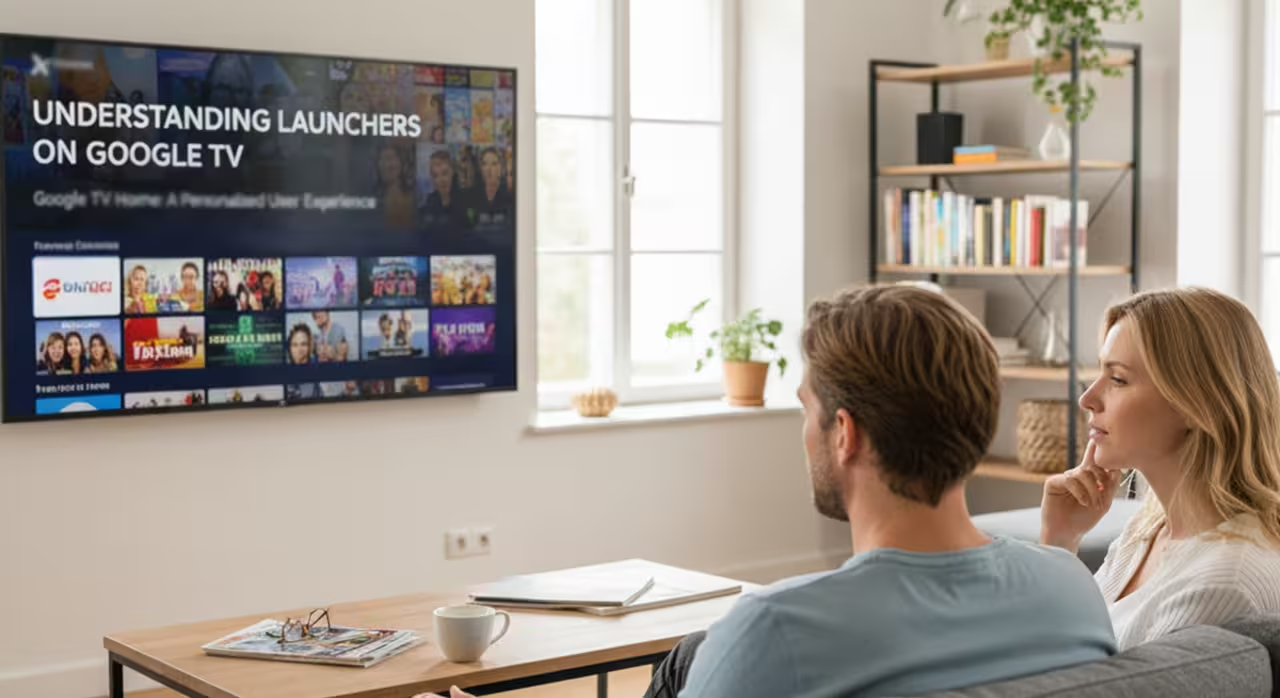
Android TV: The Foundation Layer
Under the hood, Android TV remains the underlying system component. This is essentially the “jumping-off point” for all activity on Android TV devices. It provides the technical foundation (Android OS) that ensures stability, and compatibility with Google TV Home or alternative Android TV launcher solutions.
Google TV Home: A Personalized User Experience
Google TV Home, launched in September 2024, is the modern, standard launcher on top of Android TV designed for retail devices. It provides a personalized, content-first interface that aggregates recommendations across multiple streaming services. Instead of forcing the user to browse individual apps, it surfaces relevant shows, movies, and live TV content in a unified and visually rich experience.
This personalization is powered by Google’s recommendation engine, which considers user behavior, subscriptions, and trending titles. This boosts engagement as viewers spend less time searching and more time watching.
A Shift in the Standard Launcher
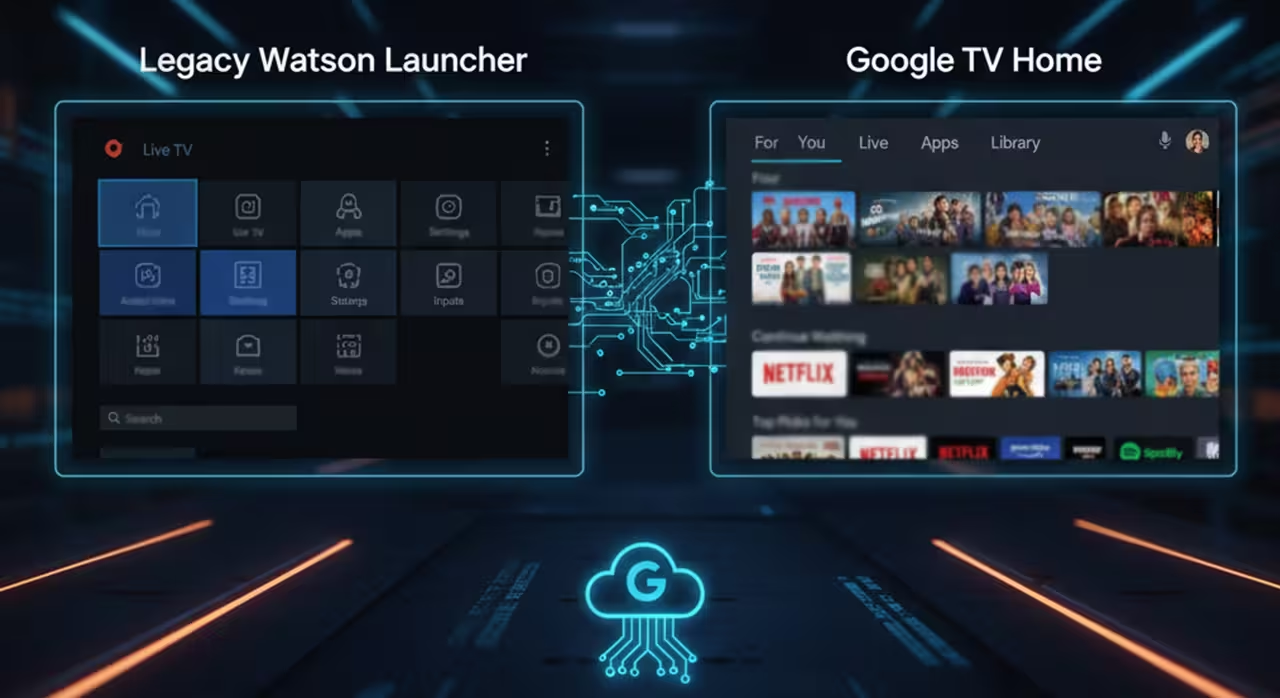
For nearly a decade, Google’s standard launcher for Android TV devices was the (now) legacy Watson launcher. Many operators launched their first Android TV projects using Watson because it offered a stable, familiar interface and required minimal development.
However, Google has since transitioned to the modern Google TV Home experience.
For operators, this transition represents more than just a UI refresh. Google TV brings deeper personalization, broader service integrations, and a tighter link to Google’s content ecosystem all of which shape how users interact with TV services.
Operator Tier Launchers: Understanding the Difference
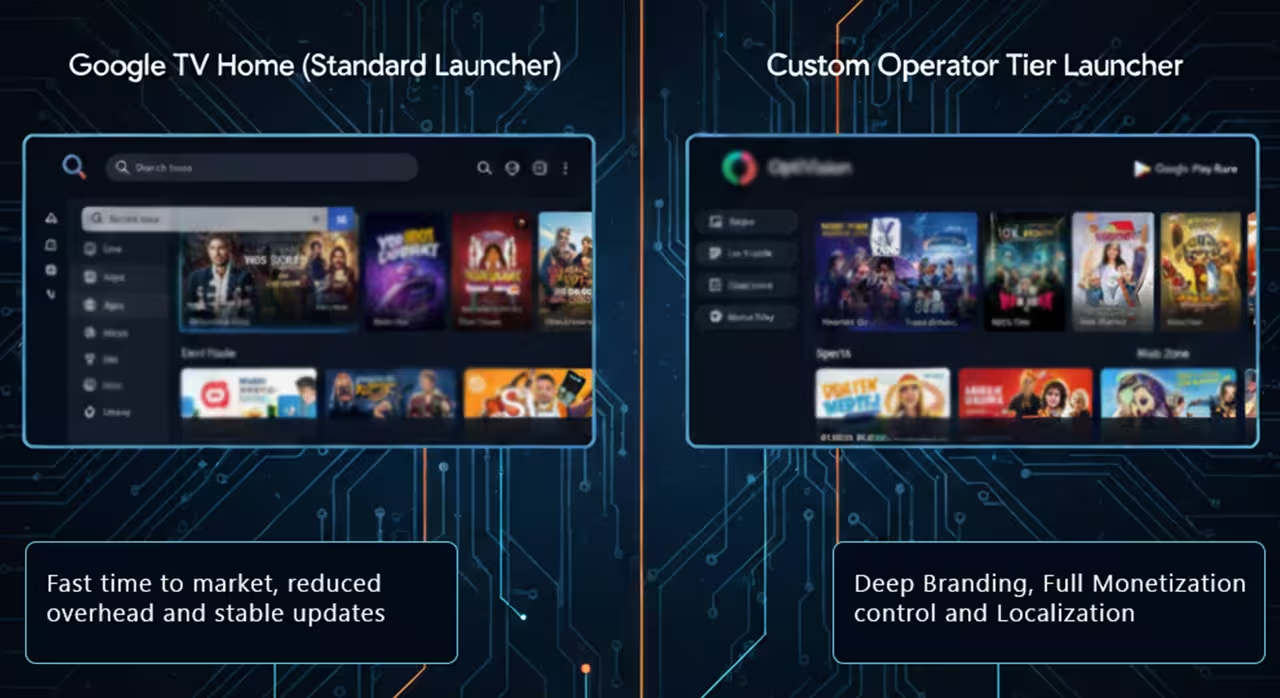
When launching an Android TV Operator Tier service, operators typically choose between two approaches: the standard launcher (Google TV Home - successor of Watson standard launcher) or a custom launcher implementation through the Operator Tier program.
Note: In the industry, there are two types of standard launchers: one for the Retail Tier program and one for the Operator Tier program. This article specifically refers to the Operator Tier version when we speak of standard launcher, which, despite its similarities to the Retail Tier, offers operators basic UI customizations to align with their brand.
Operator Tier Standard Launcher (Google TV Home)
The standard launcher is a Google-managed home screen experience. It offers a fast and cost-efficient path to launch an Android TV service. Since Google maintains and updates the UI, operators benefit from:
- Rapid time-to-market without lengthy development cycles.
- Reduced operational overhead, as updates and stability improvements are handled by Google.
- Built-in personalization through content recommendations and search integration.
- Full access to the Google TV ecosystem, including Google Assistant and the Google Play Store.
However, this approach limits branding opportunities. Operators can integrate their content and apps, but the overall look and feel are controlled by Google. Advertising inventory and promotion slots are also managed by Google, which can restrict revenue opportunities.
Operator Tier Custom Launcher
The Operator Tier program enables a fully customized launcher, giving operators complete control over the user interface and experience. This includes:
- Deep branding that places the operator’s identity at the center of the TV experience.
- Custom monetization strategies with full control over ad placement and promotions.
- Integrated presentation of linear, VOD, catch-up TV, NPVR and third-party content in a single UI.
- Localization and regulatory customization.
This approach provides maximum flexibility and differentiation but also demands more time, higher investment, and greater operational responsibility. The operator must develop, certify, and maintain the launcher in alignment with Google’s guidelines.
In general, Google was previously open for operator tier mostly for larger operators, but lately it is also possible for smaller operators to get it. Contact us if you need help.
Note: An operator tier launcher is a prerequisite for getting Netflix, but obtaining Netflix on an operator tier launcher platform is entirely achievable for operators.
Scenarios and Use Cases: Choosing the Right Option
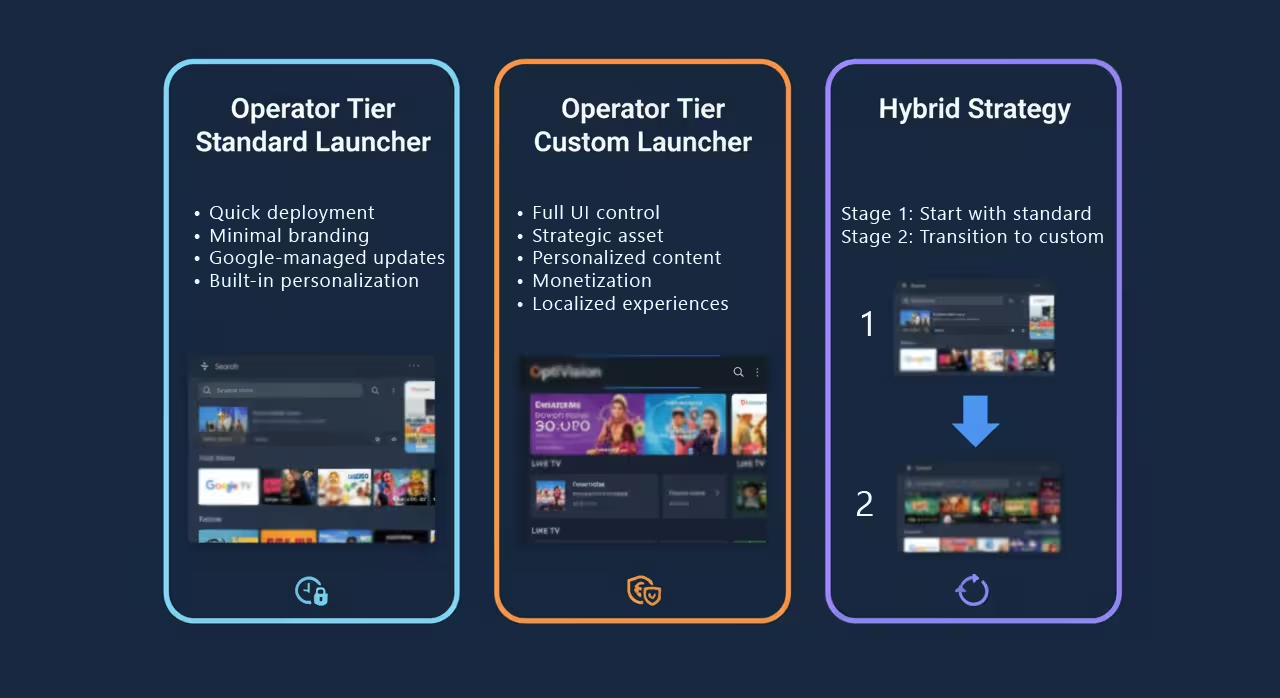
Historically, the standard launcher was particularly well-suited for smaller and mid-sized operators, seeking speed to market or facing limitations with vendors unable to deliver custom solutions efficiently. However, the landscape has evolved. Today, even these operators can access custom launchers. Furthermore, if they choose a vendor offering a pre-certified, off-the-shelf launcher, speed to market is no longer a concern.
Choosing between the operator tier standard launcher and operator tier custom launcher implementation is ultimately a strategic decision that depends on an operator’s business model, brand goals, and technical resources. Each approach brings distinct benefits, and understanding the right fit can determine the success of a TV platform rollout.
When the Operator Tier Standard Launcher Makes Sense
While offering a quick deployment pathway and minimizing initial investment, this approach means compromising on branding and strategic control. The reliance on Google's management and updates bypasses lengthy development cycles, allowing operators to launch services faster.
Similarly, the platform's built-in personalization and recommendation features provides a baseline modern experience, useful for those who can’t develop their own features, helping to keep subscribers engaged and reducing churn in competitive markets.
For operators entering new or emerging markets, the standard launcher also provides a straightforward, low-friction path to delivering a professional TV service by ensuring compliance with Google’s guidelines and access to the full Google TV ecosystem. However, this often means accepting a generic access layer rather than a truly differentiated brand experience.
When the Operator Tier Custom Launcher is the Better Fit
On the other hand, the Operator Tier program, especially when partnered with an agile and experienced partner like UniqCast, offers a powerful alternative for operators of all sizes, from small to large, who are seeking full control over their user interface and experience without sacrificing speed.
Unlike the past, where custom launchers were often perceived as lengthy, bespoke development projects, a partner provides an off-the-shelf client application that has been pre-certified multiple times for operator tier custom launchers. This means operators can deploy quickly, often within a comparable timeframe to a standard launcher, while providing complete flexibility and a truly customized UI.
With a custom launcher, the launcher transforms into a strategic asset. Operators can define precisely how users interact with content, from the home screen layout to the integration of live TV, on-demand assets, and apps. This is invaluable for operators pursuing aggressive monetization and content promotion strategies, allowing them to reserve prime screen real estate for their own services, upsell premium content, and integrate their advertising inventory. Your brand becomes the front door to the entire entertainment experience, rather than just one tile among many.
Furthermore, a provider of a custom launcher should enable operators to tailor the experience to local market needs, including language, content carousels, and regulatory compliance. While a custom launcher is inherently more demanding than a standard one, choosing the right partner ensures a fast deployment, lower upfront investment, and a uniquely differentiated product that builds loyalty and drives ARPU growth over time.
Curious if a custom launcher is right for your operation? Contact UniqCast for a consultation to analyze your current situation and discover how our easily integrated platform can empower your custom launcher vision.
Hybrid Strategies
Some operators adopt a hybrid approach, starting with the standard Google TV Home launcher to establish market presence quickly and then transitioning to operator tier custom launcher as their subscriber base grows and their business model matures. This phased strategy enables them to balance cost and speed in the early stages with control and differentiation in later phases. It also allows operators to validate their content offering and gather user behavior data before committing to a more expensive, fully branded UI initiative.
Today, this hybrid approach is still viable, but we at UniqCast recommend starting with a custom launcher from the start, as the cost and speed of deployment do not differentiate as much as they did in the past. It also makes sense and is more efficient to choose a custom launcher that is an already developed, off-the-shelf product, rather than opting for custom development. However, it is important that the launcher supports UI layouts, allowing the operator to customize the UI on their own without dependency on the vendor and without additional development cycles.
Technical Considerations: Migration and Customization
A launcher strategy has significant technical implications for deployment, maintenance, and long-term scalability. Whether migrating from the Watson launcher or deciding between standard and custom operator tier launcher, operators must address several key areas.
Migration Path from Watson to Google TV
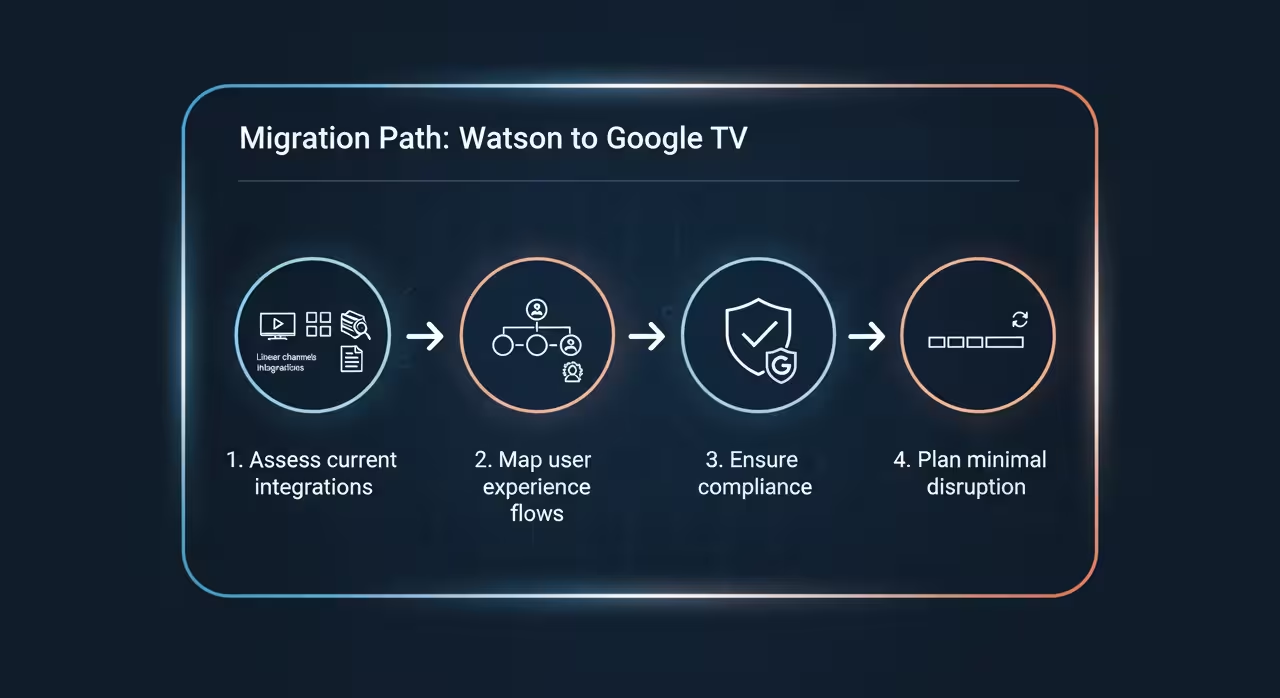
For operators currently using the Watson launcher, migration to Google TV Home represents a modernization opportunity. A structured migration plan should include:
- Assessing current integrations with linear channels, apps, and content feeds.
- Mapping user experience flows to understand how existing journeys will translate to Google TV’s personalization model.
- Ensuring compliance with Google’s updated certification and UX requirements.
- Planning minimal disruption to end users by phasing migrations or offering opt-in updates.
This process is less about “replacing” a UI and more about integrating with a new content discovery framework that prioritizes personalization and voice-driven search.
Customization and Integration Strategy
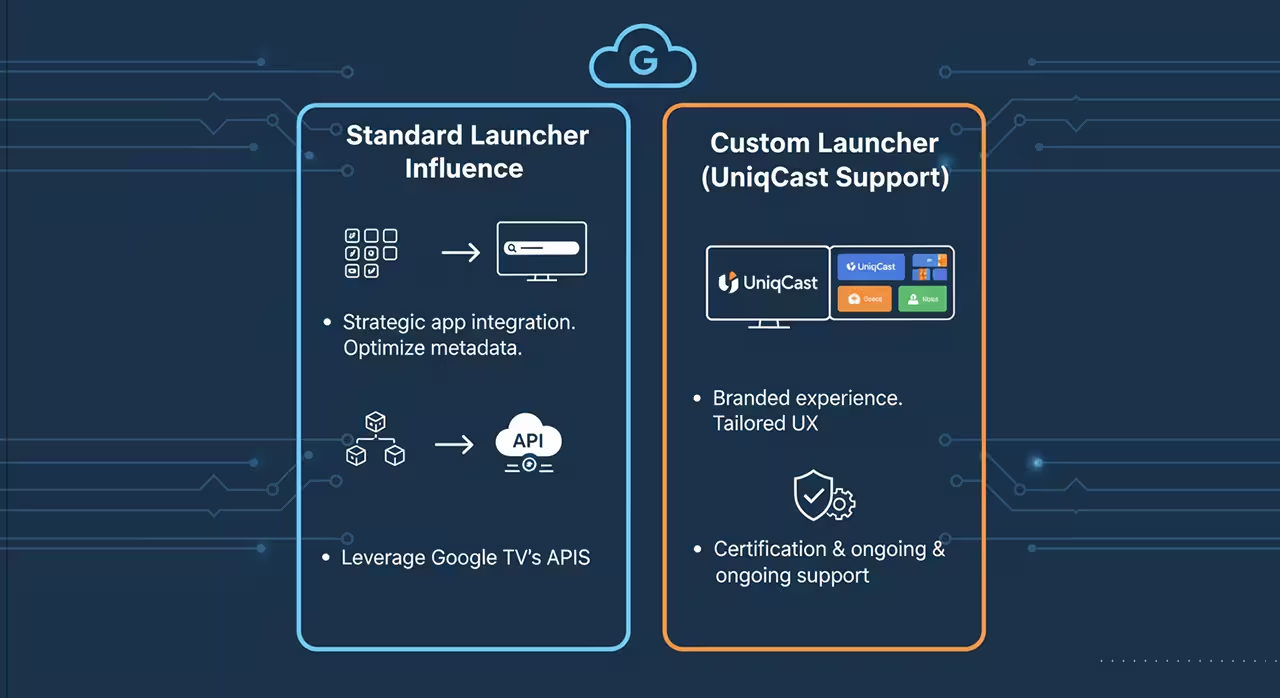
Even with the operator tier standard launcher, operators have opportunities for influence and optimization. This includes:
- Integrating their apps and channels strategically so they surface prominently within the launcher.
- Optimizing metadata (titles, categories, descriptions) to increase content visibility in recommendations and voice search results.
- Leveraging Google TV’s APIs and content ingestion tools to ensure consistent, high-quality presentation of their services.
For operator tier custom launcher deployments, while there's a bit more technical complexity, this option enables opportunities for operators to truly differentiate themselves. UniqCast offers support to operators who need to complete these steps:
- Develop or integrate a fully branded launcher experience that meets Google’s technical and UX guidelines.
- Undergo a rigorous certification process, including testing for performance, compliance, and navigation behavior.
- Plan for regular software updates and feature evolution to maintain compatibility with new Android TV OS releases.
- Establish robust monitoring and support processes to ensure a stable end-user experience.
Updates, Maintenance, and Long-Term Stability
The operational implications of the launcher decision are often underestimated. Standard launcher Retail Tier benefits from Google’s regular updates, security patches, and UI improvements, effectively outsourcing a large portion of the maintenance burden from the end user.
In contrast, Operator Tier deployments place the responsibility for lifecycle management squarely on the operator, though in all cases, the STB vendor is responsible for firmware upgrades. This includes coordinating these updates, ensuring app compatibility, and implementing UI refinements over time. The biggest difference to the standard launcher is that with a custom launcher, the operator or their chosen middleware vendor is responsible for the maintenance of the custom launcher.
Operators should also consider fallback and recovery strategies. In some cases, technical issues or delays with custom launcher updates can impact the entire platform. Building in the ability to temporarily revert to standard launcher behavior, or having a robust staging environment, can significantly reduce operational risk.
Future Outlook: What Operators Should Expect

The transition to Google TV as the standard launcher reflects Google’s long-term vision for a personalized, content-centric home screen. For operators, this means:
- Watson remains supported but has now a modern successor Google TV Home.
- Google TV Home will continue to evolve, offering richer recommendations, smarter integrations, and deeper ecosystem connectivity.
- Early adopters of Google TV-based deployments will benefit from longer platform stability and more predictable feature evolution.
- Operator Tier remains a strategic option for differentiation but requires a reliable partner with a ready made product.
Recommendations for Operators

As Google solidifies Google TV Home as the standard, operators are at a critical decision point. The launcher strategy chosen today will shape the user experience, monetization potential, and operational complexity of their platform for years to come.
Operators should begin by aligning their launcher strategy with their business objectives. Those seeking a simple and effortless market entry with minimal technical overhead could consider the operator tier standard launcher. However, the landscape has evolved. Today, even these operators can access custom launchers. Especially, if they choose a vendor offering a pre-certified, off-the-shelf launcher, speed to market is no longer a concern.
For larger or more mature operators, operator tier custom launchers provide a powerful opportunity to differentiate. Full control over the home screen enables deep brand integration, advanced monetization strategies, and tailored user journeys. However, it requires a commitment to ongoing development and operational maintenance that not all organizations are equipped to handle.
A phased deployment model may offer the most flexibility. By launching first on the standard launcher, operators can establish their presence, grow their user base, and fine-tune their content strategy. As the platform matures, they can then transition to an operator tier custom launcher experience, bringing their branding and monetization ambitions to life without sacrificing early speed.
Finally, operators should avoid long-term dependency on Watson. While still supported for legacy projects, it will probably not receive new approvals or future innovations. Planning for a forward-looking launcher strategy today minimizes migration risks tomorrow and positions operators to capitalize on the Google TV ecosystem.
Conclusión
The home screen is a strategic battlefield for user attention, engagement, and monetization. With Google’s shift from Watson to Google TV Home as the standard launcher, operators face a clear strategic choice between fast deployment with a polished Google-managed interface and full control through a custom Operator Tier experience.
The choice of launcher significantly influences the user experience, brand perception, and monetization potential of a platform. By making this decision with a long-term vision and integrating it with their overarching content and business strategies, operators can secure a strong position in the OTT TV market.
Looking for your own Operator Tier launcher? Where to start? Operators looking to upgrade their Google TV standard launcher with a custom Operator Tier launcher should contact Uniqcast for a consultancy, a demo of a custom launcher, or a direct call to get more details about the solution.




